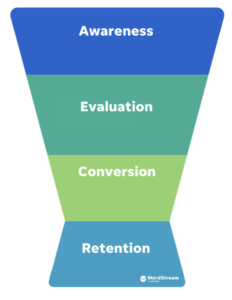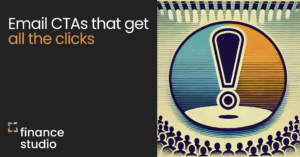You’re pumped up for a new quarter of content calendar creation, ideation, and execution.
But when writer’s block hits you as inevitably as a market correction, you need help. That’s when a solid content strategy comes into play.
If you struggle with planning your content calendar with a purpose and creating a more efficient content marketing strategy, keep reading.
Enter the content funnel

The content funnel reflects a general snapshot of the stages in which your website visitors and potential customers will potentially engage with your content depending on where they are along the journey from prospect to repeat customer.
Developing your content calendar by thinking in terms of these stages can help you create endless ongoing content ideas for any editorial calendar.
The funnel is not a new concept. And the stages could easily be applied to other marketing or sales cycles, too.
While there are other more complicated funnels out there, all of them cover three key “top-level” stages: Awareness, Evaluation, and Conversion; followed by one “bottom-level” stage, Retention.
Let’s talk about it!
The Awareness stage
Awareness content has one goal, and that’s to generate and engage website traffic.
When people visit your website, they’ve just entered your sales funnel. So it’s critical to think of ways you want your target audience to notice you at this stage.
According to HubSpot, at this point, a buyer is trying to solve problems, get answers, or meet a need. They’re looking for top-level educational content, like blog posts, social content, and e-books, to help direct them to a solution.
The content types and topics required here may include timely, newsy, or quick-answer blog posts that will help this audience notice what you offer right away.
Above all, this content should attract certain readers (buyers) over others (non-buyers), educate, entertain, encourage a subscription to your newsletter, and begin a business relationship.
While these prospects are not high-value leads at this stage, if your content is helpful enough, even non-buyers can become brand evangelists.
Those who do find your content helpful and interesting may journey on to the middle of the funnel. There, you can begin moving them down the path to purchase with tactics like email marketing or ad retargeting, which will promote and encourage further steps.
Awareness content types:
- Blog posts
- Videos
- Infographics
- Integrated social media campaigns
Awareness topics may include:
- Who you are
- What you do
- Why your product or service matters
- How it all works
- How to sign up
- Features and Benefits
Metrics to Monitor
Measuring the success of your Awareness-stage content requires tracking specific metrics. These include website traffic, social media engagement (likes, shares, and comments), content shares, and bounce rate.
> Website Traffic: Indicates the reach and visibility of your content.
> Social Media Engagement: Shows how well your content resonates with your audience and prompts interaction.
> Content Shares: Demonstrates how valuable your audience finds your content—valuable content gets shared.
> Bounce Rate: A lower bounce rate suggests visitors are staying on your site longer, indicating engagement.
Tracking these metrics provides insights into what’s working, helping you refine your strategy and focus on the content types that generate the most interest.
Pitfalls to Avoid
Even with the best intentions, it’s easy to make mistakes at the Awareness stage. Avoid these common pitfalls:
> Overly promotional content: This stage isn’t about selling; it’s about educating and attracting your audience.
> Lack of Value: Content that doesn’t answer questions, solve problems, or engage will lose your audience quickly.
> Neglecting SEO Basics: Without optimizing for relevant keywords, your content may never reach its intended audience.
> Ignoring Audience Needs: Failing to understand your audience can result in content that feels irrelevant or out of touch.
CTA Strategy
Calls-to-action (CTAs) at this stage should be subtle and non-intrusive, focusing on inviting further engagement rather than pushing a sale.
For example:
> Encourage newsletter sign-ups with phrases like, “Want more tips like this? Subscribe here.”
> Offer free resources like e-books or checklists that align with your audience’s interests.
> Include links to related content that keeps visitors exploring your website.
These CTAs guide prospects naturally without overwhelming them, making it easier for them to take the next step.
Collaboration with Other Teams
Collaboration with sales or customer service teams can be invaluable for creating Awareness-stage content. These teams interact with prospects and customers regularly and can provide insights into frequently asked questions, common concerns, and recurring pain points.
For instance:
> Use customer service FAQs as inspiration for blog posts or explainer videos.
> Collaborate with sales to understand what initial touchpoints spark customer interest.
By tapping into these insights, your Awareness content will feel more relevant and aligned with what your audience truly needs.
According to Moz, your goals might include nudging a few potential customers toward conversion, but the way to go about that is rarely by talking about yourself. Instead, it’s about figuring out what the audience wants and needs to learn about and then teaching them those very things in an engaging, down-to-earth manner.
If you’re doing that part well enough, prospects will associate their feelings of gratitude and respect with your brand, which gives you authority. All the while, you’re raising the competence of your readers to a point where the products or services you offer are more useful to them.
Next post, we’ll discuss the Evaluation stage of the content funnel. Stay tuned!
